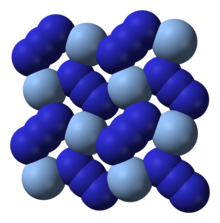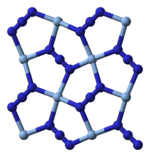Silver azide

| |
| Identifiers | |
|---|---|
3D model (JSmol)
|
|
| ChemSpider | |
| ECHA InfoCard | 100.034.173 |
PubChem CID
|
|
CompTox Dashboard (EPA)
|
|
| |
| |
| Properties | |
| AgN3 | |
| Molar mass | 149.888 g/mol |
| Appearance | colorless solid |
| Density | 4.42 g/cm3, solid |
| Melting point | 250 °C, explosive |
| Boiling point | decomp. |
| Solubility in other solvents | 2.0×10-8 g/L |
| Structure | |
| Orthorhombic oI16[1] | |
| Ibam, No 72 | |
| Hazards | |
| Occupational safety and health (OHS/OSH): | |
Main hazards
|
Very toxic, explosive |
| NFPA 704 (fire diamond) | |
Except where otherwise noted, data are given for materials in their standard state (at 25 °C [77 °F], 100 kPa).
| |
Silver azide is the chemical compound with the formula AgN3. This colorless solid is a well-known explosive.
Structure and chemistry
Silver azide can be prepared by treating an aqueous solution of silver nitrate with sodium azide.[2] The silver azide precipitates as a white solid, leaving sodium nitrate in solution.
- AgNO
3 (aq) + NaN
3 (aq) → AgN
3 (s) + NaNO
3 (aq)
X-ray crystallography shows that AgN3 is a coordination polymer with square planar Ag+ coordinated by four azide ligands. Correspondingly, each end of each azide ligand is connected to a pair of Ag+ centers. The structure consists of two-dimensional AgN3 layers stacked one on top of the other, with weaker Ag–N bonds between layers. The coordination of Ag+ can alternatively be described as highly distorted 4 + 2 octahedral, the two more distant nitrogen atoms being part of the layers above and below.[3]
 |
 |
 |
 |
3 |
In its most characteristic reaction, the solid decomposes explosively, releasing nitrogen gas:
- 2 AgN
3 (s) → 3 N
2 (g) + 2 Ag (s)
The first step in this decomposition is the production of free electrons and azide radicals; thus the reaction rate is increased by the addition of semiconducting oxides.[4] Pure silver azide explodes at 340 °C, but the presence of impurities lowers this down to 270 °C.[5] This reaction has a lower activation energy and initial delay than the corresponding decomposition of lead azide.[6]
Safety
AgN3, like most heavy metal azides, is dangerously explosive. Decomposition can be triggered by exposure to ultraviolet light or by impact.[2] Ceric ammonium nitrate is used as an oxidising agent to destroy AgN
3 in spills.[5]
See also
References
- ^ Marr H.E. III., Stanford R.H. Jr. (1962). "The unit-cell dimensions of silver azide". Acta Crystallographica. 15 (12): 1313–1314. doi:10.1107/S0365110X62003497.
- ^ a b Jacqueline Akhavan (2004). The chemistry of explosives (2nd ed.). Royal Society of Chemistry. pp. 30–31. ISBN 0854046402.
- ^ Schmidt, C. L. Dinnebier, R.; Wedig, U.; Jansen, M. (2007). "Crystal Structure and Chemical Bonding of the High-Temperature Phase of AgN3". Inorganic Chemistry. 46 (3): 907–916. doi:10.1021/ic061963n. PMID 17257034.
{{cite journal}}: CS1 maint: multiple names: authors list (link) - ^ Andrew Knox Galwey; Michael E. Brown (1999). Thermal decomposition of ionic solids (vol.86 of Studies in physical and theoretical chemistry. Elsevier. p. 335. ISBN 0444824375.
- ^ a b Margaret-Ann Armour (2003). Hazardous laboratory chemicals disposal guide, Environmental Chemistry and Toxicology (3rd ed.). CRC Press. p. 452. ISBN 1566705673.
- ^ Jehuda Yinon; Shmuel Zitrin (1996). Modern Methods and Applications in Analysis of Explosives. John Wiley and Sons. pp. 15–16. ISBN 0471965626.

